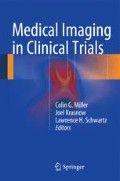Abstract
There are four key uses for medical imaging: screening, diagnosis or prognosis, monitoring the natural history of the disease, and monitoring therapeutic intervention. There are eight key metrics when evaluating a biomarker or imaging technique which has to be put into context with the key use of the system. This chapter will describe these key metrics in this context with particular emphasis of the use in clinical trials.
Access this chapter
Tax calculation will be finalised at checkout
Purchases are for personal use only
References
Conroy RM, et al. Measurement error in the Hawksley random zero sphygmomanometer: what damage has been done and what can we learn? BMJ. 1993;306(6888):1319–22.
Guidelines for preclinical and clinical evaluation of agents used in the prevention or treatment of postmenopausal osteoporosis. Available from: http://www.fda.gov/ohrms/dockets/dockets/98p0311/Tab0026.pdf.
Guidance for industry standards for clinical trial imaging endpoints. Available from: http://www.fda.gov/downloads/drugs/guidancecomplianceregulatoryinformation/guidances/ucm268555.pdf.
Kastelein JJ, et al. Simvastatin with or without ezetimibe in familial hypercholesterolemia. N Engl J Med. 2008;358(14):1431–43.
Genant HK, et al. Vertebral fracture assessment using a semiquantitative technique. J Bone Miner Res. 1993;8(9):1137–48.
Sharp JT, et al. How many joints in the hands and wrists should be included in a score of radiologic abnormalities used to assess rheumatoid arthritis? Arthritis Rheum. 1985;28(12):1326–35.
van der Heijde DM, et al. Effects of hydroxychloroquine and sulphasalazine on progression of joint damage in rheumatoid arthritis. Lancet. 1989;1(8646):1036–8.
Genant HK. Methods of assessing radiographic change in rheumatoid arthritis. Am J Med. 1983;75(6A):35–47.
Guideline on clinical investigation of medicinal products other than NSAIDs for treatment of rheumatoid arthritis. Available from: http://www.ema.europa.eu/docs/en_GB/document_library/Scientific_guideline/2011/12/WC500119785.pdf.
Bruynesteyn K, et al. Deciding on progression of joint damage in paired films of individual patients: smallest detectable difference or change. Ann Rheum Dis. 2005;64(2):179–82.
Machado P, et al. Ankylosing spondylitis disease activity score (ASDAS): defining cut-off values for disease activity states and improvement scores. Ann Rheum Dis. 2011;70(1):47–53.
Pearson D. Standardization and pretrial quality control. In: Pearson D, Miller CG, editors. Clinical trials in osteoporosis. New York: Springer Science + Business Media; 2007. p. 292.
Stensland-Bugge E, Bonaa KH, Joakimsen O. Reproducibility of ultrasonographically determined intima-media thickness is dependent on arterial wall thickness. The Tromso Study. Stroke. 1997;28(10):1972–80.
Miller CG, et al. Ultrasonic velocity measurements through the calcaneus: which velocity should be measured? Osteoporos Int. 1993;3(1):31–5.
Moris M, et al. Quantitative ultrasound bone measurements: normal values and comparison with bone mineral density by dual X-ray absorptiometry. Calcif Tissue Int. 1995;57(1):6–10.
Langton CM. ZSD: a universal parameter for precision in the ultrasonic assessment of osteoporosis. Physiol Meas. 1997;18(1):67–72.
Fleming TR, DeMets DL. Surrogate end points in clinical trials: are we being misled? Ann Intern Med. 1996;125(7):605–13.
Henderson RC, et al. Predicting low bone density in children and young adults with quadriplegic cerebral palsy. Dev Med Child Neurol. 2004;46(6):416–9.
Henderson RC, et al. Bone density and metabolism in children and adolescents with moderate to severe cerebral palsy. Pediatrics. 2002;110(1):e5.
Author information
Authors and Affiliations
Corresponding author
Editor information
Editors and Affiliations
Rights and permissions
Copyright information
© 2014 Springer-Verlag London
About this chapter
Cite this chapter
Miller, C.G. (2014). The Metrics and New Imaging Marker Qualification in Medical Imaging Modalities. In: Miller, C., Krasnow, J., Schwartz, L. (eds) Medical Imaging in Clinical Trials. Springer, London. https://doi.org/10.1007/978-1-84882-710-3_2
Download citation
DOI: https://doi.org/10.1007/978-1-84882-710-3_2
Published:
Publisher Name: Springer, London
Print ISBN: 978-1-84882-709-7
Online ISBN: 978-1-84882-710-3
eBook Packages: MedicineMedicine (R0)

